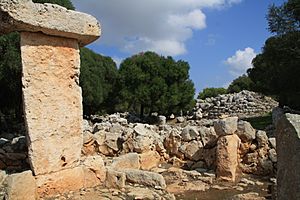Binissafullet facts for kids
Binissafullet is an amazing ancient village on the island of Menorca. It was built by people from the Talaiotic culture, who lived there during the late Bronze Age and Iron Age. People started living here around 1000 BC.
The village was most important between 400 BC and 300 BC. Later, during the Medieval period, some people also lived or visited the site. We know this because of old Islamic items found there.
Binissafullet has many cool features you often see in Talaiotic villages. These include a large stone tower called a talayot, a special area with a huge stone monument called a taula, and a covered meeting place known as a hypostyle hall. There were also homes and storage pits for food.
Contents
What is a Taula?
A taula is a giant stone monument shaped like a "T". It has a tall, upright stone with a flat stone placed on top. These were very important for the Talaiotic people. They might have been used for special ceremonies or meetings.
The Unique Taula of Binissafullet
In 1990, the taula area at Binissafullet was dug up and fixed. The giant taula stone was found lying on the ground. Workers carefully put it back upright. This taula is special because it's smaller than others. It also has a thinner upright stone.
It's the only taula on Menorca that archaeologists have put back up. The other six taulas that are still standing have been upright since ancient times!
What Did We Learn from Digging?
When archaeologists dug around the taula, they learned a lot. They found pieces of old pots called Punic amphorae. These pots were used to carry things like wine. They also found animal bones, mostly from sheep and goats.
There were also signs of a fireplace. These finds suggest that people held special events or ceremonies here. They likely ate meat and drank wine during these important gatherings. All the items found during these digs are now kept safe at the Museum of Menorca.
A World Heritage Site?
Binissafullet is one of 32 ancient sites on Menorca. These sites are part of a big plan to become a World Heritage site. This means UNESCO would recognize them as very important places for everyone in the world to protect.
How to Visit Binissafullet
You can find Binissafullet on road Me-10. This road connects the town of Sant Lluís to the Binissafúller living area. If you drive towards Binissafúller, the site is at the 2.3 km mark. It's right across from the turn-off to the residential area. You can easily see the ancient village from the road.
See also
 In Spanish: Binissafullet para niños
In Spanish: Binissafullet para niños



